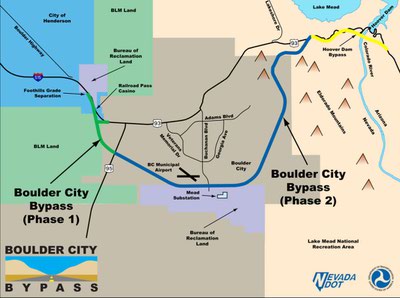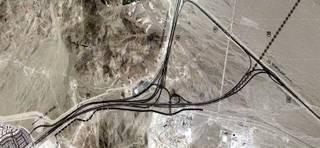Tuesday, Oct. 26, 2010 | 10:39 p.m.
Sun archives
- Boulder City: Remove U.S. 93 stretch from Canada, Mexico trucking route (8-30-2010)
- Some Henderson residents decry Boulder City Bypass plans (7-25-2009)
- Freeway to Phoenix gains traction with bridge work (7-11-2009)
- Meeting planned to discuss changes to Boulder City Bypass (7-6-2009)
- Contractor selected for $270 million I-15 project (7-1-2009)
- A boost for DesertXpress (7-3-2009)
- Clark County roads wait for stimulus while rurals get work (6-10-2009)
- Declining gas tax revenue means fewer road projects (6-9-2009)
While they’re not exactly celebrating, some residents of the southeast corner of Henderson are excited about changes to the design of part of the Boulder City bypass while political support is growing to start work on the project.
The entire Boulder City bypass project would build a new freeway circling the city, connecting Henderson to the new Hoover Dam bypass, which opened last month.
The freeway would relieve congested streets in Boulder City and would be a key piece of a proposed Interstate 11 to connect Las Vegas and Phoenix.
But the first phase of construction is almost completely in Henderson and originally had some residents upset about the impact the project would have there.
That phase, which is expected to start construction late next year, will improve U.S. 93 from where the existing Interstate 515 freeway ends at Foothills Drive to the interchange where U.S. 95 splits from U.S. 93.
The new freeway will eliminate the stoplight in front of the Railroad Pass Casino, but it also included a frontage road on the east side of the new freeway.
Residents of the River Mountain Ranch Estates and Old Vegas neighborhoods opposed the plan because the frontage road would direct traffic into their neighborhoods. They also felt they had been left out of the process because most of the meetings about the project were held in Boulder City, where the bulk of the project would be.
But two years after presenting the project’s design to the public, Nevada Department of Transportation officials held a public meeting Tuesday to show they changed the road design, moving the frontage road to the west side of the freeway.
“It’s good for us,” said Diane Booker, president of the River Mountain Ranch Estates homeowners association.
“We’re in a rural section of town; we have enough traffic now. I didn’t realize how much traffic noise I have at my house until I got new hearing aids,” she added with a laugh.
The frontage roads are required by the federal government to keep an alternative route for local traffic to use around the freeway, and city officials from Henderson said they would be important for future residential and commercial development in the area.
But they also were a priority for Boulder City residents, some of who didn’t want to be forced to drive on a freeway to get to Henderson.
It wasn’t the Henderson residents who wanted the frontage roads, Henderson City Councilwoman Gerri Schroder said, but “it’s the people here who are going to be impacted, not the people in Boulder City.”
Moving the frontage road put it farther away from homes and closer to areas that will be developed in the future.
Tim Rogers, who lives just east of the freeway near Wagonwheel Drive, said he still isn’t excited about the projects.
“It’s going to be a lot of pain and discomfort, a lot of construction,” he said. “If I had a choice, I’d keep this area as rural as possible. But, at the same time, I realize it’s a necessary evil. You have to build the infrastructure to move us into the 21st century.”
Rogers said he is pleased the major interchange for the project will be on the south side of the mountains, away from residences, and he is glad the frontage road was moved.
“It’s commendable that they are taking into consideration the residents’ concerns, because I haven’t seen very much of that in the past,” he said.
While the federal government took the lead on building the Hoover Dam bypass and the massive Mike O’Callaghan-Pat Tillman Memorial Bridge, and Arizona’s transportation department has spent millions upgrading U.S. 93 south of the dam, Nevada has had a difficult time making improvements to the road here.
“This project has been kind of on-again and off-again over the last several years, but it’s been elevated to higher priority, and the project is moving forward,” said Nevada Department of Transportation project manager Tony Lorenzi. “Our design staff is working full time on this.”
While some Henderson residents have mixed feelings about the project, Boulder City officials have been clamoring for it to be done as soon as possible.
Some Boulder City residents have expressed concern that the bypass will mean fewer visitors to the town’s businesses, but many residents are more upset about the potential of 2,000 semi-trucks returning to the city’s streets now that the Hoover Dam bypass has opened and they are allowed to stay on U.S. 93 instead of taking the Laughlin bridge to get to Arizona.
In August, the Boulder City Council passed a resolution saying the city wanted to remove U.S. 93 through the town from the Canamex trade route connecting Mexico to Canada and ban trucks from the road until the bypass was finished.
On Monday, Sen. Harry Reid sent a letter with a copy of Boulder City’s resolution to Federal Highway Administrator Victor Mendez requesting support for the project.
“As long as I’m Nevada’s senior senator, I’ll do everything in my power to make sure the Boulder City bypass is finished,” Reid said at the dedication of the Hoover Dam bypass bridge Oct. 14, an event attended by Mendez and U.S. Transportation Secretary Ray LaHood.
Local transportation officials say the full project is 10 to 15 years from construction, unless political support can somehow generate more money from the federal government.
While the first phase of the project is expected to begin construction next year, only about $70 million of the necessary $190 million has been secured, Lorenzi said.
The second phase of the bypass, the one that would actually build a freeway around Boulder City, is expected to cost an additional $270 million to $315 million.
In the meantime, starting construction on the first phase helps the project get started even though the funding is in question.
“It’s a lot easier to get a $190 million project approved than it is to get a $300 million project approved. This is a way to move it along,” Lorenzi said. “Now that the bridge is open and this project is moving forward, I think there’s a lot of political interest in moving on with the rest.”



Join the Discussion:
Check this out for a full explanation of our conversion to the LiveFyre commenting system and instructions on how to sign up for an account.
Full comments policy